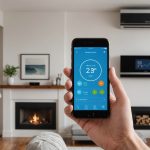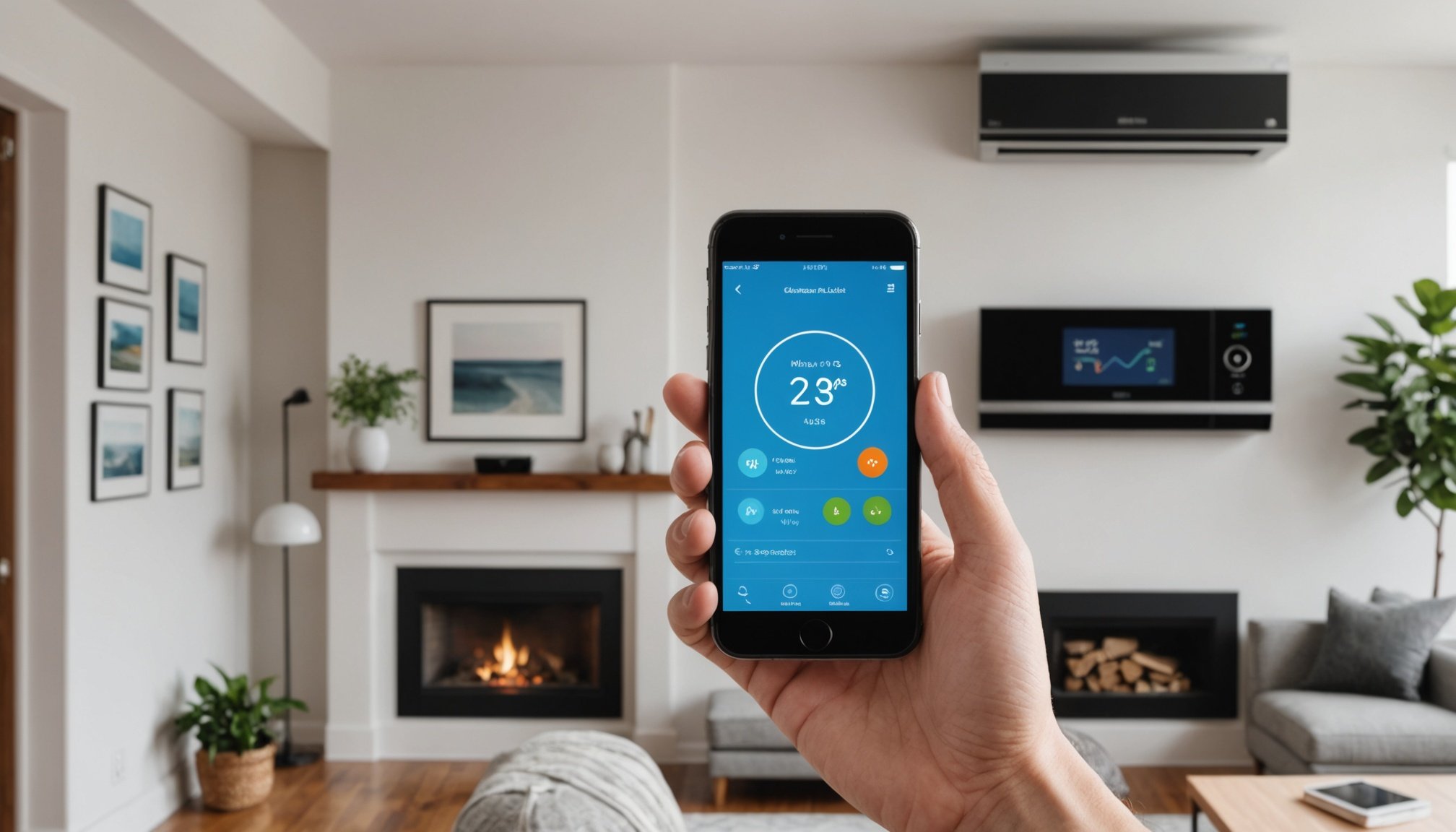Overview of Smartphone Control for Air Conditioners
Integrating smartphone control into air conditioners revolutionises how we manage our home climate. The ability to adjust settings remotely not only brings unprecedented convenience but also enhances energy efficiency and comfort. This smart home climate management approach allows users to fine-tune their environment to their precise needs, all from the palm of their hand.
Smartphone-controlled air conditioners serve as an essential component of a modern, energy-efficient home. Through an app, users can easily optimise their system for comfort while reducing energy consumption. For instance, scheduling the air conditioner to turn on just before you arrive home allows you to enjoy a comfortable temperature without running the system all day.
Have you seen this : Crafting Unforgettable Travel Itineraries: The Ultimate Smartphone Guide for Adventurous Travelers
Numerous popular smart air conditioning models boast app capabilities that enhance user convenience. Brands like LG and Samsung offer features that enable integration with other smart devices, creating a cohesive and automated home ecosystem. This modern functionality empowers users to fine-tune their living spaces, adapting to both physical and environmental changes effortlessly.
Adopting smartphone air conditioner control not only simplifies climate management but also aligns with a commitment to a sustainable and comfortable lifestyle. Enhanced control over HVAC systems underscores a shift toward a smarter, more responsive home environment.
This might interest you : Transform Your Space: Smart Home Lighting Hacks to Match Every Mood Using Your Smartphone
Key Features of Smartphone Apps for Air Conditioners
Smartphone apps for air conditioners come packed with numerous features, greatly enhancing user convenience and efficiency. Remote control HVAC capabilities are at the forefront, providing users the ability to adjust settings from anywhere. This flexibility ensures that your home is always at the ideal temperature upon your arrival. Scheduling is another standout functionality, allowing users to preset times for the air conditioner to turn on or off. This not only optimises comfort but also aids in energy efficiency, as it prevents unnecessary operation during hours when no one is home.
Additionally, temperature control within these apps allows precise management of indoor climates. Some advanced features include remote monitoring, where users can track the performance and energy use of their systems in real-time. Such insights enable informed adjustments that further enhance the efficiency of the air conditioner.
Moreover, leading brands incorporate unique functionalities within their apps. For instance, some allow integration with other smart home devices, creating a holistic system responsive to both human occupancy and environmental factors. This integration and automation provide a personalised and seamless experience, ensuring the system adapts swiftly to changing needs and scenarios.
Setting Up Your Smartphone for Air Conditioner Control
Integrating your smartphone with your air conditioning system is straightforward and enhances your smart home configuration. To begin, ensure that your air conditioner is compatible with smartphone control features. Most modern units offer this integration, but checking the model’s specifications is wise.
Preparing Your Air Conditioner for Smart Control
First, confirm that your air conditioner supports smart capabilities. If compatible, refer to the user manual for instructions on enabling smart settings. Ensure your unit is Wi-Fi ready, as connectivity is essential.
Downloading and Installing the App
Search for the air conditioner app on your smartphone’s app store, considering recommendations for your specific device type. Once found, download and install the application. Popular apps often have high ratings and numerous user reviews, aiding your selection process.
Connecting Your Device to Wi-Fi
Proper smartphone integration requires a robust Wi-Fi connection. Connect your air conditioner to the same Wi-Fi network as your smartphone. If you encounter connection issues, double-check your network details. Solutions often include moving the router closer or removing any obstacles that may interfere with the signal.
Before continuing with your setup, verify the air conditioner’s connection through the app to ensure compatibility within your smart home system.
Using Your Smartphone App to Optimize Comfort
Using smart climate control features efficiently not only maximises comfort but also boosts energy savings. Delve into your app’s scheduling features to fine-tune your environment. For instance, set the air conditioner to start cooling 30 minutes before you return home. This ensures a pleasant climate without unnecessary energy usage throughout the day.
To establish ideal temperature zones, use the app’s smart climate control settings. Adjusting these based on factors like the time of day or room usage optimizes HVAC efficiency. For instance, if you spend mornings in the living room, prioritise cooling there and decrease it elsewhere. Consistently tweaking these settings results in a comfortable and efficient environment.
Monitoring is crucial to maintaining optimal conditions. Utilise the app’s capability to adjust settings based on outside temperatures. On cooler days, lower your air conditioner usage to conserve energy and reduce utility bills. By actively tracking weather changes, the app can effectively guide your HVAC usage.
Embrace these air conditioner usage tips within the app to achieve a balanced, cost-effective home atmosphere that aligns with your lifestyle.
Troubleshooting Common Issues
Navigating air conditioner troubleshooting can enhance system functionality and ensure app performance problems are swiftly resolved. Let’s explore the most common issues and effective solutions.
Identifying Common Issues
Homeowners frequently encounter connectivity problems or performance lags. These issues often stem from Wi-Fi interference or outdated app versions. Correctly identifying these problems is essential for maintaining a stable connection and ensuring smooth HVAC maintenance.
App Performance and Connectivity Problems
If your app struggles to pair with the air conditioner, ensure the device is connected to the same Wi-Fi network. Check the app for necessary updates that might resolve performance glitches. Keep your router and devices updated, and consider minimizing interference by repositioning your router.
When to Seek Professional Help
For persistent issues despite troubleshooting, contact a professional. Situations involving complicated hardware glitches or persistent app failures warrant expert advice. Qualified technicians can provide insights into complex hardware problems and help ensure your system operates optimally.
Effective troubleshooting ensures seamless operation and maximizes the lifespan of your air conditioning system. By addressing minor issues quickly, users can prevent potential escalations, enhancing their smart home climate management experience.
Recommendations for Compatible Devices and Apps
Selecting the best smart air conditioners and apps can significantly enhance your smart home experience. In 2023, notable models such as those from LG, Samsung, and Daikin stand out for their smartphone air conditioner control capabilities. These units effortlessly sync with your smartphone, allowing comprehensive smart home climate management.
Suggested Smart Air Conditioner Models
Consider devices that are Wi-Fi ready, ensuring seamless integration with smart home systems. Brands like LG’s Dual Inverter and Samsung’s Wind-Free models are recognised for their robust app functionalities. These air conditioners offer precise control over temperature settings, making them ideal for a modern, energy-conscious home.
Leading Apps and User Testimonials
For controlling these systems, apps like LG ThinQ and Samsung SmartThings provide impressive remote control HVAC features. Users have praised the ease with which they can adjust settings and monitor system performance. One user noted, “Samsung SmartThings made managing my home’s climate intuitive and efficient.”
Matching the right app with compatible smart home devices ensures an enhanced, personalised experience. Reviews consistently highlight the added convenience and efficiency these technologies bring, ensuring your investment contributes to a balanced and responsive home environment.











